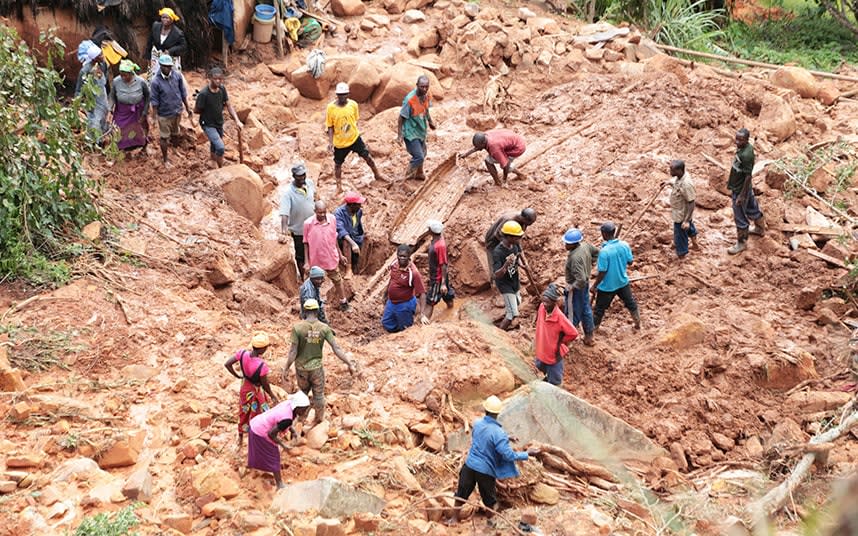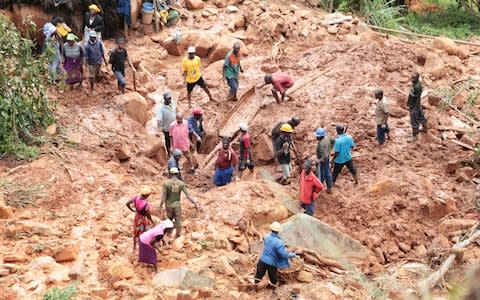Cyclone Idai: Fate of thousands unknown as rescuers struggle to reach swamped villages

The fate of entire village populations in rural Mozambique remained unknown on Wednesday as rescue workers tried desperately to reach thousands still trapped in rising floodwaters unleashed by Cyclone Idai.
Eyewitnesses told of corpses floating down swollen rivers and aerial footage showed families still perched on rooftops and in the upper branches of submerged trees days after Idai tore through three southern African states.
Britain pledged £12 million and flew tents and shelter kits into Mozambique to aid an international rescue operation set up in the flooded port city of Beira that often seemed in danger of being overwhelmed by the sheer scale of the disaster.
With 90 per cent of the buildings in Mozambique’s fourth city damaged or destroyed, aid workers struggled to respond to the basic needs of Beira’s 500,000 people, most of whom have neither shelter nor food and water.
But there was far greater concern for the fate of those living in villages in the cyclone’s path, many of which have been wholly inundated by flash floods and the waters of rivers that burst their banks.

“Many people are in a desperate situation, fighting for their lives at the moment, sitting on rooftops, in trees and other elevated areas,” said Christophe Bouleriac, a spokesman for the UN children’s fund Unicef.
Eyewitnesses spoke of seeing “hundreds” of corpses floating down swollen rivers and hearing screams from people clinging to tree branches suspended over potentially crocodile-infested waters six days after Idai made landfall.
South Africa’s army contributed helicopters, the Indian navy ships, while local fishermen and small boat owners made repeated trips in their canoes to rescue the stranded.
A Zimbabwean living in Mozambique reportedly strung 20-litre containers to the back of his boat for the rescued to cling to as for three days he moved from tree to tree and rooftop to rooftop rescuing survivors.
Yet even these herculean efforts seemed barely to make a difference. Aid workers said they had been forced to prioritise, rescuing children and pregnant women from some trees but being forced to leave the rest where they were.
So huge is the challenge that one aid worker likened it to the evacuation of British troops from Dunkirk.
The death toll from the disaster officially rose to more than 350, some 200 in Mozambique and the remainder in the highlands of eastern Zimbabwe and Malawi.
But how many may have actually died is anyone’s guess, with unconfirmed reports of hundreds dead in just a handful of villages outside Beira alone.
“Everyone is doubling, tripling, quadrupling whatever they were planning,” said Caroline Haga of the Red Cross. “It’s much larger than anyone could ever anticipate.”

Even though it did not bear the brunt of the cyclone, Zimbabwe’s Chimanimani district suffered destruction unprecedented in its modern history. Perence Shiri, the acting defence minister who visited the area, said it resembled “the aftermath of a full-scale war”.
Nearly all bridges in the region were reportedly washed away while sinkholes made many roads impassable. Another minister said bodies had been washed down swollen rivers across the border into Mozambique.
As in Mozambique, the rescue effort was often left to private individuals.
Doug Van der Ruit, a local businessman, and Bob Henson, a former farmer, have flown repeated missions in their small helicopter ferrying medicines and evacuating victims from cyclone-affected areas along the border between Zimbabwe and Mozambique.
“We don’t known how many are missing, nor how many have died,” said Mr Henson, who lives in Harare, Zimbabwe’s capital.

“But we hope we saved some. Hundreds of houses were smashed down. We flew over some funerals.”
Many of the victims, including those who need urgent medical attention, cannot get to nearby hospitals, he added, because of impassable roads and collapsed bridges. Among those the two men flew out of the affected area was a dying woman in labour.
Mr Van der Ruit witnessed some of the devastation wrought by the cyclone first hand, saying he saw large chunks break off surrounding mountains and come crashing down.
“We heard this roaring,” he said. “Rocks falling everywhere — no thunder or lightning, just sheets of water, and wind and roaring.”
Although meteorologists had warned for a fortnight that a cyclone was on its way, many in rural Mozambique and Zimbabwe were caught unawares and there appears to have been little government effort to carry out a pre-emptive evacuation.
Protect yourself and your family by learning more about Global Health Security

 Yahoo News
Yahoo News 